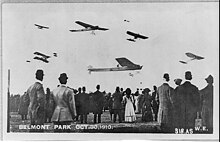The National Aeroplane Fund was sanctioned by the Aero Club of America in response to perceived military and political disinterest in aeronautics. Established in summer 1915, the group lobbied Congress to increase funding for military aeronautics. The purpose of The American National Aeroplane Fund was to train aviators, provide aviation corps for the National Guard and Navy Militia of the States and U.S. Possessions, and put aeroplanes in use for the mail carrying service to inaccessible places, forming an aeronautical reserve, which while being used daily for peaceful purposes shall be ready for military service in case of need.
The U.S. Army and Navy have, together, less than twenty planes available. Only half a dozen of the licensed aviators of the United States have made flights of more than fifty miles, and none even know the rudiments of aeronautical requirements. Our Army, Navy, National Guard and Navy militia have had no experience in handling aircraft or operating with them.
If England, with 1,500 aeroplanes and aviators and the output of sixteen thousand men cannot supply sufficient aeroplanes for its forces - what could Uncle Sam - who has less than a score of aeroplanes - do in case of immediate need?
To provide an aeronautical reserve, the Governors of the Auto Club of America have started a public aeronautical subscription, similar to the French and German subscriptions of 1912-1913. These netted $1,222,969 and $1,808,626 respectively, and were used to train aviators and to procure aeroplanes. As the New York Sun says editorially, "Surely we in America, with our greater resources, can do even better."
French and German Air Fleet Built by Public Interest
The French and German aeroplane fleets of to-day were built largely by public subscriptions and through public interest. In February, 1912, soon after the first employment of aeroplanes in the French military manoeuvres demonstrated the potentiality of the ajr service, but the French Govemment failed to allow the appropriations necessary to secure an adequate aeronautical organization for the French Army, a public subscription was started.
In every part of France, the people-men and women, rich and poor, young and old, and of all beliefs and factions-united their efforts with the Press and political, social, professional and sportive organizations, and all contributed their share to give France a large aerial fleet. This public subscription brought 6,114,846 francs and gave France 208 aeroplanes, 62 landing stations for aeroplanes and 75 trained aviators. The public interest created by the subscription was tremendous and led to the immediate consideration of the aeronautical needs of France by the Government. By April, 1914, the French Army possessed 1,200 aeroplanes and 28 dirigibles, and most complete and efficient equipment.
Germany's aeroplane fleet was built almost entirely by the public subscription started by the Aerial League of Germany in 1912 which brought 7,234,506 marks. The purpose of the League was to train within the shortest time as large a number as possible of aviation pilots to form a reserve and to encourage the general development of aviation in Germany. Following are some of the results obtained;
The number of pilots was 230 at the end of 1912; it increased to 600 by the end of 1913; the constructors of aeroplanes were less than 20 in 1912, they increased to 50 by the end of 1913. The developments due to the efforts of the Aerial League led to Reichstag to pass a plan providing for an expenditure of $35,000,000 for military aeronautics in the following five years.
During the first month of 1914 the inducements offered by the Aerial League of Germany led to the breaking, by German aviators, of all the world records. By the middle of July, the non-stop endurance record was carried up to 24 hours and 12 minutes, by Reinhold Boehm, and the altitude record to 26,246 feet, by Heinrich Oelrich. Over one hundred other records, similar to the above were made. For instance, Basser and Landsmann made continuous flights of 18 hours 11 minutes and 21 hours 49 minutes respectively, in one of which Landsmann covered 1,336 miles, which is the longest distance ever traveled by man in one day. Among the records for altitude was the record of Otto Linnekogel of 21,654 feet- which is about the height of Mount McKinley!
Just as the people in every part of France and Germany-men and women, rich and poor, young and old, and of all beliefs and factions, united their efforts with the Press and political, social, professional and sporting organizations-we here in America can do the same.




